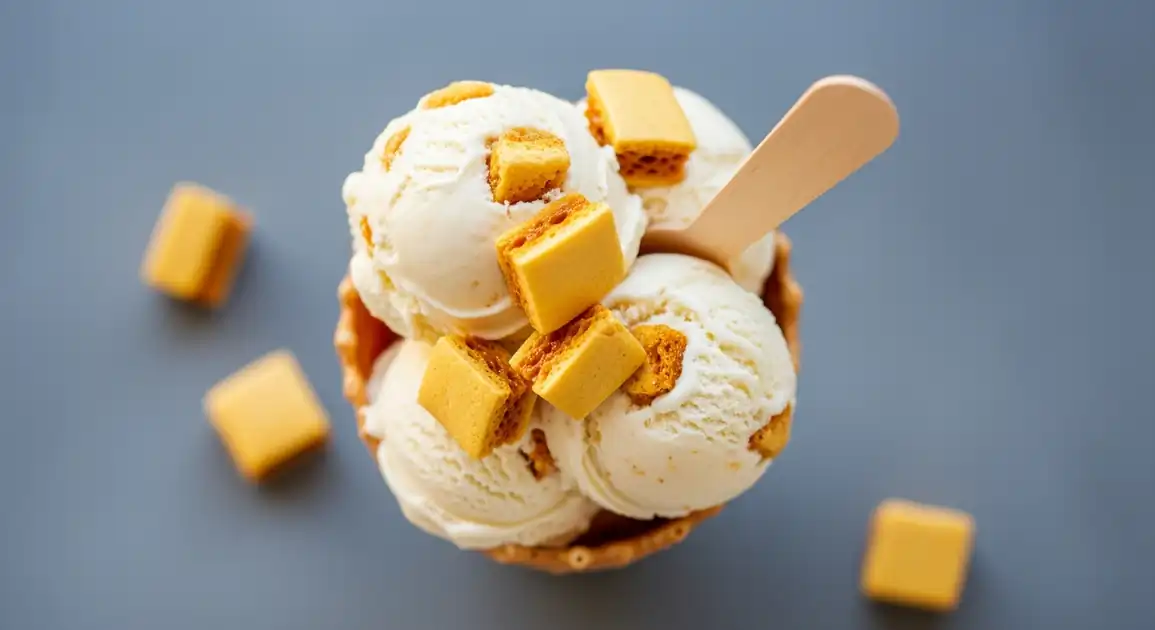Hokey Pokey Ice Cream
Hokey Pokey Ice Cream

Description
Hokey Pokey ice cream is considered New Zealand's unofficial national ice cream flavor, second only to vanilla in popularity. Available virtually everywhere that sells ice cream across the country, from supermarkets to beach kiosks. New Zealanders take immense pride in this local specialty, and visitors are often encouraged to try it as part of their Kiwi culinary experience.
Dietary Information
Serving information
Serving style
Typically served in cones or cups. Single scoops are standard, but double or triple scoops are common. Sometimes served as an accompaniment to warm desserts in cafes and restaurants. Pre-packaged options include tubs, ice cream bars, and individual servings.
Quick facts
Ice cream shops typically operate from 11 AM - 9 PM, with extended hours (10 AM - 10 PM) during summer and weekend evenings.
Safety Tips
What to Look For
-
Well-maintained freezers at proper temperature
Ice cream should be firmly frozen but scoopable. If it's too soft or shows signs of melting and refreezing, this indicates poor temperature control.
-
Clean serving equipment and environment
Scoopers should be clean, and the overall environment should meet basic hygiene standards with staff using appropriate serving techniques.
-
Proper storage containers and coverage
Ice cream should be stored in covered containers when not being served to prevent contamination and ice crystal formation.
-
Natural color and appearance
Quality Hokey Pokey has a creamy off-white or pale yellow base with golden honeycomb pieces. Avoid unnaturally bright yellow coloring or honeycomb that looks very dark (overcooked) or pale (undercooked).
What to avoid
-
Ice crystals or freezer burn
These indicate improper storage, temperature fluctuations, or that the ice cream is old. Look for smooth, consistent texture.
-
Strange odors or rancid smell
Dairy products can absorb odors or develop off-flavors when stored improperly or past their prime.
-
Very dark or extremely pale honeycomb pieces
Very dark pieces may be burnt and bitter, while extremely pale pieces may be undercooked and lack flavor.
-
Long-term exposed ice cream in display cabinets
Open display cabinets that aren't properly maintained can lead to temperature abuse and potential contamination.
Price information
Price range
Budget tips
- Supermarket tubs (1-2 liters) offer the best value, ranging from 5-8 NZD.
- Convenience stores often sell single-serve Tip Top sticks or small cups for 4-5 NZD.
- Artisanal ice cream shops charge premium prices (6-12 NZD per scoop) but offer gourmet quality.
- Many places offer discounts for double or triple scoops compared to buying singles.
Value indicators
- Generous honeycomb pieces distributed throughout, not just on top.
- Smooth, creamy ice cream base without ice crystals.
- Natural appearance without artificial coloring.
- Proper temperature and consistency (firm but scoopable).
- Heavier weight when served suggests higher dairy fat content.
Where to Find This Dish
Coastal Areas
Beach kiosks and shops in seaside suburbs are popular spots to enjoy this classic treat.
Popular beaches, Waterfront areas, Tourist promenades
Afternoon, Weekend
Shopping Districts
Mall food courts and downtown areas often have specialty ice cream shops.
Shopping malls, Main shopping streets
Afternoon, Evening
Tourist Attractions
Visitor hotspots almost always have vendors selling this iconic Kiwi treat.
Major tourist sites, Observation decks, Tour ending points
Midday, Afternoon
Vendor Tips
- Specialty ice cream shops typically offer better quality than general convenience stores.
- Look for shops with high turnover to ensure freshness.
- Some places offer sampling before purchase - take advantage to find your preferred style.
How to Order
Regional Variations
-
Gourmet Hokey Pokey
(Gourmet Hokey Pokey)
Premium versions with higher quality dairy, often featuring vanilla bean specks and larger, more rustic honeycomb chunks. May have a richer egg custard base.
-
Chocolate-Dipped Hokey Pokey
(Chocolate-Dipped Hokey Pokey)
Hokey Pokey ice cream bar or scoop dipped in chocolate coating, sometimes with additional honeycomb pieces embedded in the chocolate.
-
Hokey Pokey with Chocolate Swirl
(Hokey Pokey with Chocolate Swirl)
Traditional Hokey Pokey ice cream with added chocolate ripple or fudge sauce swirled throughout.
-
Dairy-Free Hokey Pokey
(Dairy-Free Hokey Pokey)
Made with coconut, oat, or soy base instead of dairy cream, catering to vegans and those with lactose intolerance. The honeycomb pieces are typically vegan by default.
-
Double Hokey Pokey
(Double Hokey Pokey)
Contains extra honeycomb pieces or larger chunks for those who prefer more toffee in each scoop.
-
Boutique Hokey Pokey
(Boutique Hokey Pokey)
Artisanal versions that might incorporate unique elements like sea salt, different honey varieties, or caramelized sugar techniques for the honeycomb.
Cultural context
History
Hokey Pokey ice cream has been a New Zealand staple since the mid-20th century. While its exact origins are disputed, the term "hokey pokey" has been used in New Zealand since the late 1800s to describe honeycomb toffee. The ice cream variant gained widespread popularity in the 1940s-50s when Tip Top, New Zealand's largest ice cream manufacturer, began mass-producing it. The name itself may derive from an old ice cream vendor's call of "hokey pokey" or from Cornish origins, where "hocky pockey" referred to a type of honeycomb sold by street vendors.
Local significance
Hokey Pokey is considered New Zealand's unofficial national ice cream and a point of culinary pride. Second only to vanilla in popularity, it's a flavor that most Kiwis grow up with and have strong nostalgic connections to.
Eating customs
- Typically eaten immediately after purchase rather than saved for later.
- Often enjoyed while walking along the beach or at outdoor gatherings.
- When served in a cone, Kiwis typically eat it before it melts in the often-warm climate.